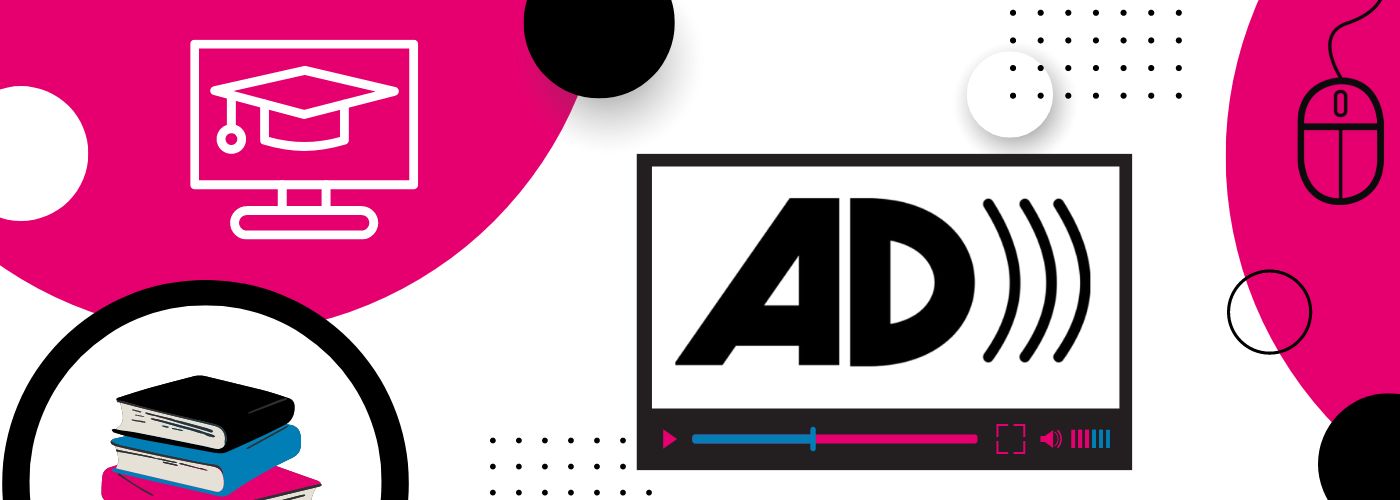Audio Description for Online Learning
Updated: January 30, 2023
What to look for in an audio description vendor ➡️
The COVID-19 pandemic and the speedy evolution of technology has resulted in a significant increase in the number of educational organizations providing online learning options for students instead of teaching in a traditional classroom.
Online learning offers students the convenience and flexibility to learn new skills and topics, acquiring knowledge whenever and wherever they see fit.
Many students prefer an online experience because they can work at their own pace, access personalized learning, and pursue passions outside of the classroom.
As eLearning continues to gain popularity, it’s imperative that all students have equal access to educational content that lives online.
Audio description (AD), also referred to as described video, is the translation of visual images to vivid language for the primary benefit of people who are blind or have low vision. Audio description is a great tool to make your content accessible to a wider audience.
In addition, audio description benefits people who are on the autistic spectrum, multi-taskers, and auditory learners.
Read on if you’re considering adding AD to your videos or want to learn more about audio description for online learning.
Why is Audio Description Important for Online Learning?
Accessibility
According to the World Health Organization, at least 2.2 billion people are living with some form of vision loss. Audio description meets accessibility requirements so that viewers who are blind and low-vision can access your content.
Without audio description, your content becomes inaccessible to a large group of people who want to engage with your video. These are potential students you could be excluding.
Legal Compliance
In addition to making your videos accessible, there are many laws in place that protect people with disabilities such as the Americans with Disabilities Act, the Rehabilitation Act, and the 21st Century Communications and Video Accessibility Act. These laws protect individuals and ensure equal access.
Multiple universities have been sued for inaccessible online content. Cases like NAD v. MIT and NAD v. Harvard were triggered by the universities’ inaccurate auto captioning on their free online programming and platforms, such as YouTube, iTunesU, Harvard@Home, and MIT OpenCourseWare. Both MIT and Harvard eventually reached settlements with the NAD that strengthened digital accessibility policies.
Quality Descriptions
Well-done, accurate descriptions are important to educational organizations. Poor descriptions may deliver incorrect information and a compromised learning experience to students who rely on AD. With so much video content, it’s imperative that the descriptions are clear and concise for users. Oftentimes, online learning videos will have complex diagrams and graphs. High-quality descriptions ensure your viewers will understand vital information shown in your video.
Improved Learning Outcomes
Research has proven that the brain processes information through visual and auditory channels. When you watch a video with audio description, you can accommodate and process a greater amount of new information.
One of the draws for eLearning is that students can find courses that accommodate their learning styles. 20-30% of students say that they retain information best through sound. Audio description is a helpful aid for auditory learners and can assist all individuals in acquiring new information as they watch educational material.
What are Common Challenges in Audio Description for Online Learning?
Scalability

Ease of Use/Workflow
The process of traditional audio description is quite labor-intensive and time-consuming. Unlike captions, most players don’t support audio description. This makes publishing another hurdle – and often even an added expense. It’s important to find a vendor that understands how to simplify the workflow and offers tools to make publishing efficient.
Cost
Creating high-quality AD requires a lot of time, attention to detail, and a high level of skill. Because of the expertise and equipment required to produce audio description, it can quickly become costly. With prices significantly higher than the cost of closed captioning – ranging from $15 to $75 per minute – many don’t have the budget to regularly implement audio description on video content.
Year after year, cost has been the number one reason why organizations don’t implement accessibility into their video initiatives. The challenge can be finding an audio description vendor that doesn’t break the bank but also doesn’t drop the ball on quality. Luckily, there are solutions available that deliver high-quality descriptions at competitive prices.
In order to afford audio description, educational institutions need a solution that meets their budget. However, there may be an even greater risk if audio description isn’t provided. Violating the law can lead to potential lawsuits and legal fees.
Understanding What’s Important to Describe
When describing the visual elements of a video, it’s important to focus on what is essential for the user to know. For eLearning videos, you may want to focus on certain aspects of a graph, diagram, who is speaking, or if there is more than one speaker. Knowing what to describe is dependent on how much time is allotted for the descriptions and how relevant the information is to understand the content.
Remember that students rely on the description to consume the content and your description should never be confusing or misleading. High quality description enhances and complements the media to make it more easily understood.
Quality/Accuracy
Accurate descriptions are essential to understanding the information in a video. Without it, your video becomes inaccessible and incomprehensible. eLearning companies want to ensure that the audio description vendor they choose follows the DCMP comprehensive guide, which outlines best practices for high-quality audio description.
Questions to Ask an Audio Description Vendor
What Vendor Features are Important in Audio Description for Online Learning?
Competitive Pricing

Since we use a combination of technology and human describers, we’re able to offer audio description starting at $9 per minute for standard AD and $14 per minute for extended AD. No matter which option you decide to go with, we always guarantee high-quality descriptions.
Easy Publishing
Because most players don’t support audio description, many times the only way to publish is to link to a second version of your video that contains the description. This can take up additional time and resources that were not originally accounted for.
At 3Play Media, our goal is to make publishing as easy as possible. We integrate with a number of video platforms that support audio description, like Ooyala, Brightcove, and JW Player – just to name a few. But what if you don’t use any of the platforms we integrate with? No worries! The Access Player allows you to embed the descriptions into your video for seamless publishing with any platform. The Access Player also allows viewers to toggle the description on or off, and lets them control the volume of the description, which is separate from the main track.
Accuracy and Option to Edit
In order to ensure content that is both accessible and enjoyable to your viewers, it must be accurate. 3Play Media follows the DCMP Description Key to ensure high-quality descriptions for all videos. Our descriptions are accurate, prioritized, consistent, appropriate, and equal. We offer glossaries to allow account users to list any tricky terms, pronunciations, or provide notes to editors on what information to prioritize. If needed, there’s a preview and edit feature which allows users to edit descriptions in just a few clicks.
Online Learning Platforms Using 3Play Media






